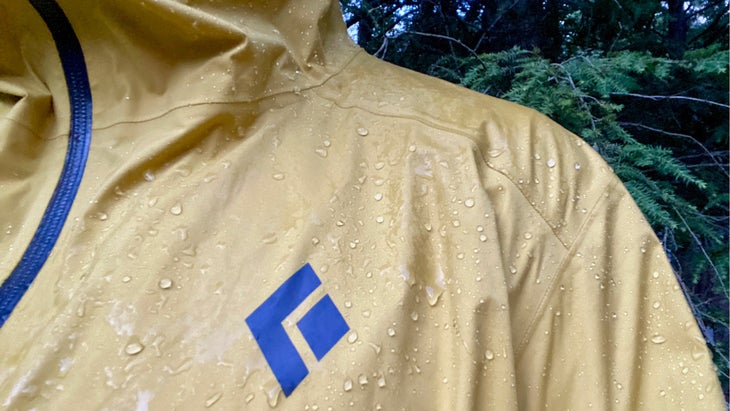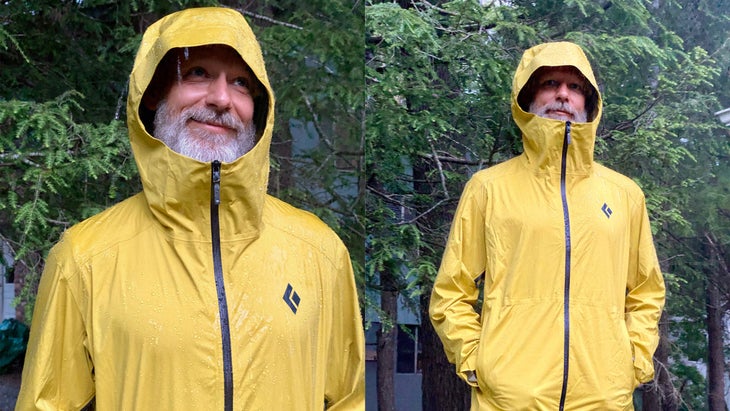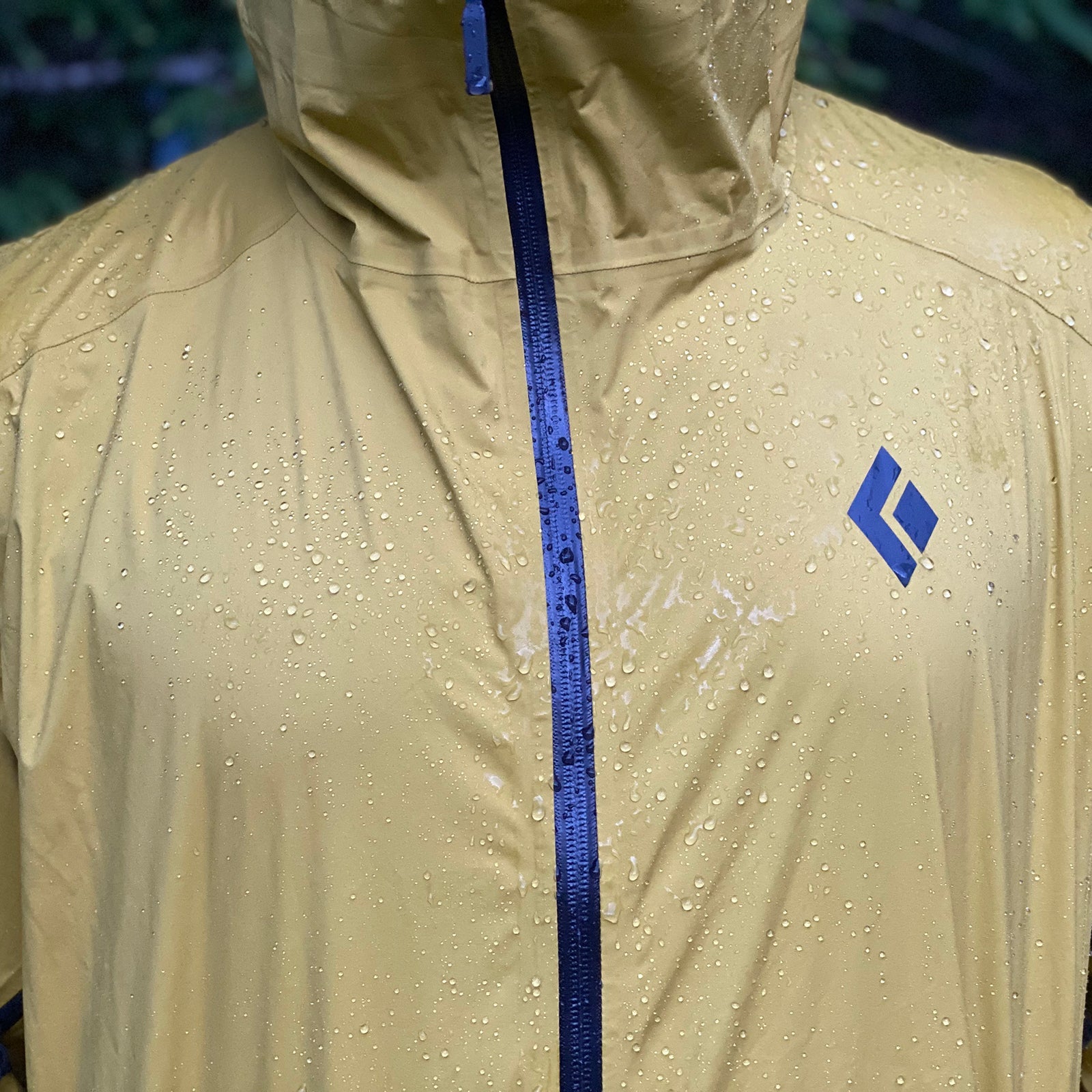When you live in the southern Appalachians, like I do, you have to ignore the weather forecast—there’s always rain on the horizon. Afternoon thunderstorms are as ubiquitous as sweet tea down here, so if you let them deter you, you’ll never get anything accomplished. Instead, you should invest in a good rain jacket and go about your adventures. And I do mean invest, because they’ve gotten expensive. If you want something that doesn’t feel like you’re wearing a trash bag, you can expect to spend a couple hundred bucks. If you want one with more performance-minded features, then you can add a Benjamin or two to that price tag. Or you could consider ($149, sizes XS to XXL), which trends toward the budget side of the price spectrum but offers the comfort and details you’d expect from a high-end performance shell.
I tested the Stormline for more than two months in the rainforest I call home. I hiked, biked, walked the dog, and watched my kids’ soggy soccer games. I even had my son hose me down in our front yard. What I found was a unicorn—it hits the sweet spot of affordability and performance.
What I Like
Thanks to Black Diamond’s proprietary BD.dry tech, a 2.5-layer face fabric with a DWR treatment, the Stormline has a 10K/10K waterproof/breathability rating (more on that here), which means it can handle moderate rain while remaining breathable during activities like hiking, scrambling, or climbing. Its seams are fully taped and the front zipper is waterproof, an asset that helps prevent moisture from creeping into a jacket’s typical weak points. It weighs just over 11 ounces (in a men’s medium) and packs into its own pocket, so it’s easy to stash inside a pack. There’s also a carabiner loop in the corner of that pocket so you can hang it from your pack if interior space is limited.

Although the Stormline weighs just a few ounces more than ultralight emergency shells, it has a suite of features typically found on more robust rain jackets: Velcro adjustable cuffs, a cinch-cord hem, pit zips, and a hood that accommodates a helmet. What stands out, though, is the nylon-elastane build, which gives the Stormline its stretch—just enough to keep it from feeling restrictive when you’re climbing or belaying—coupled with a slightly textured liner that helps battle that clammy feeling when you start to sweat.

This isn’t the only jacket on the market with all of these goodies. Most high-end models now incorporate at least a little bit of stretch and a soft liner. But such jackets are often twice as expensive as the Stormline. And even with a higher price, they’re often missing one or more of the Stormline’s attributes. Maybe the more expensive alternative won’t have pit zips, or it won’t stuff into its own pocket. With this Black Diamond coat, you get it all at half the price of similar jackets.
What Could Be Improved
The Stormline doesn’t have everything I want in a raincoat. It has two hand pockets, which is wonderful, but no chest pocket, which drives me crazy because I like to carry my phone close to my chest if I’m moving quickly. It’s also bulkier than most performance shells, which is slightly off-putting if you’re used to a more athletic cut. (However, that extra room does allow you to layer, if you’re dealing with serious weather.) And it’s not the most breathable raincoat on the market. I found the Stormline to be breathable on casual bike rides around town in a drizzle, or at a hiking pace, but if you’re trail-running, you’re going to overtax its breathability. The pit zips help, but they can only do so much.
The Upshot
On one testing day, I pushed a gravel ride a little harder than I intended while wearing this jacket, and experienced that clammy feeling we all hate. Then again, it isn’t made for long trail runs or “Everesting” on a gravel bike, so maybe I need to manage my expectations of what this shell can and can’t do. But the Stormline Stretch can do a lot. It’s ultralight but feature-rich, and priced beneath the competition, making it the ideal shell for my soggy adventures in this region.
Three Other Rain Jackets I Like
Columbia Titanium OutDry Ex Stretch ($180, sizes X to XXL)
With the , Columbia forgoes a DWR coating for a permanent waterproof exterior that does a wonderful job at keeping the rain out, and it will last for years. I dig the style, too—but it isn’t as breathable, light, or packable as the Stormline Stretch.
Patagonia Torrentshell ($149, sizes XS to XXL)
A traditional three-layer rain jacket, the has a lot of the same details as the Stormline (adjustable cuffs, a hood, can be packed into its own pocket). Bonus: it has a soft fleece-lined collar and is constructed from 100 percent recycled nylon. Yet it’s not as stretchy as the Stormline and weighs a little more.
Arc’teryx Zeta SL ($300, sizes XS to XXL)
The 10.9-ounce is built for performance. It uses Gore-Tex’s Paclite two-layer waterproof system and has a soft interior for a great next-to-skin feel. It’s loaded with features, but it’s missing pit zips and doesn’t stuff into its own pocket. Still, it’s a hell of a rain shell.


